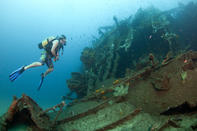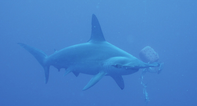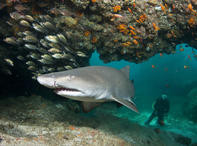The Produce
The Produce is an old cargo vessel that was carrying molasses and was travelling from Durban, heading south when it struck the pinnacles on Aliwal Shoal in 1974.

There were no lives lost as a rescue party launched from the Umkomaas River managed to reach her and saved all the people on board. It is 119 m long and lies facing north. She has come to rest on her starboard side and her back is broken leaving her midship very flat and scattered. Her propeller has been salvaged, however, her spare prop can still be seen on her bow.
There are a number of swim-throughs for the more experienced diver and it is advisable to take a torch on this dive as light does not penetrate all the swim-throughs. A host of very shy giant Brindle bass about 3m long and 1,5m wide could be seen, as well as Harlequin goldies all around the wreck; they are endemic to the wreck and can only be found on her and Nebo.
Scorpionfish and Stonefish are regularly found on the wreck, camouflaged and blended into the scenery. Manta rays and game fish can also be spotted in the big blue if the visibility is good. The coral on this wreck consists of more soft than hard coral. Some of the soft coral found here includes, Fire coral, Whip coral, Green fern coral, Polyp coral and yellow Turret coral.
Manta Point
At Manta Point huge rock formations are found with caves big enough for Ragged-tooth sharks to fit in, and overhangs and ledges with clouds of fish hiding underneath. Swim-throughs and gullies are also on the list of interesting landscaping in this area.
Ragged-tooth sharks are regularly seen in November, usually found patrolling the gullies and caves in this area. Schools of tropical fish are also found, along with an array of hard and soft coral on the edges of the reef. There are parts of the reef that look as if it has been draped with Leather coral with bits of sea grass in between and a sea urchin here and there. This is a great multi-level dive.
The Nebo

The Nebo is reported to have been carrying materials for the Van Stadens River Bridge back in the 1800s when she was sunk due to incorrect loading. She was very top-heavy and when she encountered rough seas she simply went belly up and sank.
The wreck, which is over 100 years old, is broken into two main parts. If the visibility is good or you have an experienced dive master, it is a simple navigation exercise to get from one part to the other.
One regular fish species found swimming in and out of the wreck on this reef is the Natal catfish. Harlequin goldies, which are endemic to this area, are also seen on the wreck. Round ribbontail ray, Sharp-nosed stingray and Greyspot guitarfish are just a few visitors in the sand around the Nebo.
Squid and Scorpionfish are also found lingering about with schools of fusiliers, tuna and Hammerhead sharks. Keep an eye out for game fish patrolling the area. Soft coral, such as Green Fern coral, different colours of Polyp coral and Green and Yellow turret coral are found on this wreck. The different dive sites on the Aliwal Shoal have something to cater for everyone’s taste - including the shark fanatics.
Chunnel
Expect to find a cave full of sharks and tropical fish on this dive, but be aware that not a lot of light penetrates the cave, making it quite a frightening dive. Chunnel, which is near Raggie’s Cave, was named as such because it is a waterway where sharks constantly move.
The marine life in this area consists mainly of Ragged-tooth sharks which patrol the area. Turtles have been spotted as well as Sand sharks and Ribbontail rays in the sand patch nearby. Raggie Scorpionfish are also common in the area. The fish life includes Wrasse and some tropical reef fish. Coral is not that plentiful on this reef.
Raggies Cave

This area has rock formations with a great amount of caves, overhangs, gullies and swim-throughs. Big caves, where you can easily fit in a couple of scuba divers, are often also inhabited by Ragged-tooth sharks.
The coral life consists mainly of hard coral with fewer reef fish to be found. In the gullies and crevices the juvenile fish hide during the day with False stonefish and Scorpionfish also commonly found in this area. Shark’s teeth can be found inside the cave and also in the surrounding sand patches.
This dive site is known worldwide for the Ragged-tooth sharks that populate the reef.